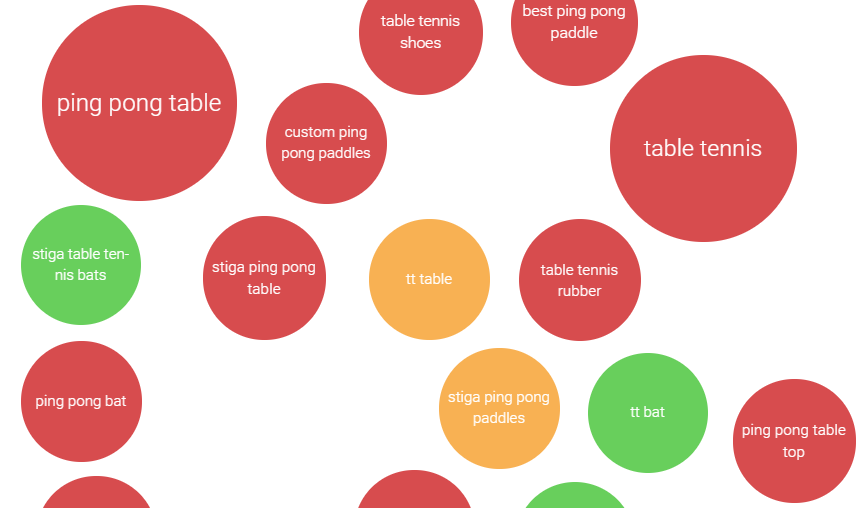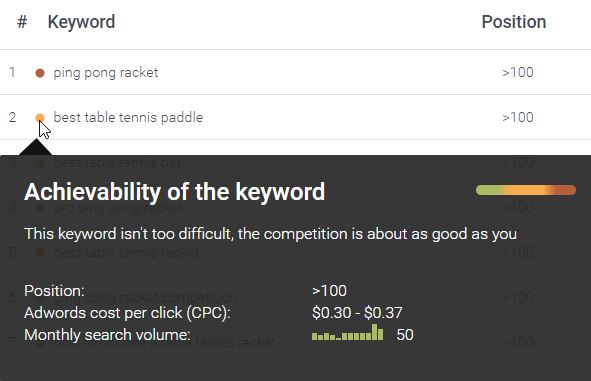How to Do Keyword Research for SEO?
How to Do Keyword Research for SEO?
In the continuation of the beginner’s guide series for search engine optimization (SEO), we started by introducing 3 types of SEO that can improve the ranking of a website in search engines. Before diving deeper into these methods, let’s take a closer look at one of the foundations of SEO:
What are keywords and why are they important for SEO?
On the web, keywords are words or phrases that identify the main topics of a web page. For website visitors, Keyword Research is what they type (or speak) into a search engine like Google. For search engines, keywords are used to group and rank websites that are relevant to people searching for specific content online.
For example, if you’re looking for a custom sink installation service, Google will try to list the most relevant pages that contain those specific words (also called keywords or key phrases).
Since the goal of SEO is to improve your web page’s ranking in search results, choosing the right keywords is an important first step. While many other factors affect your website ranking, choosing the wrong keywords is a surefire way to lose traffic and potential business, so try to get it right from the start!
But how do you make sure you choose the right keywords for your web page? Let’s read and find out!
How to choose the best keywords with keyword research
Finding the best keywords involves a series of steps that must be completed in a specific order to get the best results. Some steps will generate new keyword ideas while others will help you narrow down your keyword options and eliminate those that don’t work for you.
You will read below:
- Specify the objectives and the topic
- Brainstorm primary keywords
- Consider longer keyword phrases with modifiers
- Quality modifiers
- Place modifiers
- Time modifiers
- Interrogative modifiers
- Expand your keyword list with suggested keyword tools
- What are people really looking for? Identify search volume
- Identify low-competition keywords: the best keywords to target for traffic
- Limit the list of keywords
- The best keywords for your goals
- Search for competitors
- Create a shortlist of keywords
Specify the objectives and the topic
Before starting the keyword research process, it is important to set a goal. What do you want your web page to do?
Here are some examples:
- Generate sales of a specific product
- Generate traffic
- Lead generation (email/phone collection)
- Increase brand awareness or recognition
To begin, write down the main purpose of your page. You can have multiple goals, but ideally, each individual web page you create should target one main goal.
We’ll come back to goals later in this article and see how they will affect our final keyword selection, but for now, focus on identifying your goals before you start doing keyword research. Failing to do this could mean you’re working backwards and adapting your goals based on your keyword research, which can ultimately backfire.
You also want to define the theme of the page. Your theme should be the general idea of the page you are creating. If you focus on your home page, the theme may be quite general as it will be the main idea of your entire website. Other pages should be more specific, such as a service, product, news or topic.
For example, if you have a website that provides information about ping pong equipment, that would be the topic of your home page. Then other pages deal with specific pieces of ping pong equipment and perhaps related news. It’s important to have a theme for every web page you create because it helps you focus on keywords and which ones to ignore.
Now that we’ve set a goal, let’s move on to the next step: brainstorming.
Brainstorm primary keywords
Start by trying to answer a simple question:
If you were to find your page online, what terms would you search for?
Since different people think differently, you might include your friends or colleagues at this stage and use the whiteboard to maximize creativity.
Let’s say you have a ping pong website and you want to create a page on ping pong paddles. Take a few minutes and brainstorm between 3 and 10 keywords.
Examples:
- Ping pong handles
- Ping pong accessories
- Ping pong racket
After the initial brainstorming, think of synonyms. Your customers or visitors may use different words while searching for the same topic. Depending on how many synonyms you find, your list can quickly double.
Examples:
- Table tennis handles
- Table tennis equipment
- Table tennis racket
Expand your keyword list with keyword suggestion tools
Once you have a comprehensive list of possible keywords, let’s use online tools to recommend new keywords that you may have overlooked.
Here we suggest 4 tools:
- WordTracker – Identify the search volume, level of competition, and purchase intent for any keyword available by geographic region. Try it for free (plus 25% off premium versions).
- rankingCoach – Discover new keywords with this user-friendly tool that guides you through the process. Easily sort them by popularity and competition and let the tool find your most likely competition. Then make those keywords work for you!
- Ubersuggest – a completely free tool that provides a lot of information about keywords, related keywords and how difficult it is to rank in search engines.
- Google Ads Keyword Planner – If you have a Google Ads account, you have access to one of the most popular keyword tools on the market today. It’s a powerful tool, but to access its full potential you need to run a Google Ads campaign.
Type the keywords from your brainstorming list into the tool to start collecting data. Review the suggested keywords and note down keywords that seem relevant to your topic and that you may have overlooked. For example, rankingCoach suggested table tennis handles as a common search term, which I was unaware of when researching ping pong handles.
After you’ve found a few new and relevant keywords and flagged them, you’ll move on to adding modifiers. These modifiers help you discover keyword opportunities that your initial brainstorming and tool-assisted research missed.
Consider longer keyword phrases with modifiers
Keywords are often divided into two categories: short-tail and long-tail. Short tail keywords consist of 1 to 3 words and long tail keywords (sometimes known as keyphrases) consist of 4 or more words. While shorter keywords may generate more search volume and exposure, longer keywords can actually provide higher quality visitors with less competition, so they shouldn’t be ignored (more on search volume later and competition we will explain more).
Let’s now expand our brainstorming keyword list by adding modifiers. These are words that are usually added to the beginning or end of your keywords. We will focus on 4 specific types of modifiers: quality, place, time, and question.
Quality modifiers
Qualities can be something general, like best, worst, cheapest, or most expensive. They can also be specific to your topic, such as “Ping Pong Team for Defensive Players”. Think about what features people might be searching for in relation to your current listing and expand your keyword list with them.
Examples:
- The best ping pong handles
- The most recommended ping pong handles
- Table tennis rackets to control the ball
Place modifiers
Search engines recognize that some searches, such as ordering pizza, are local. If your page topic targets a specific region (which it almost always should), add that modifier to your keyword research list.
Time modifiers
Some web pages are time-sensitive, and adding a time modifier, such as the current calendar year, a special holiday, or a current event, can help increase interest. For example, the best ping pong rackets of 2022 may be more popular than the best ping pong rackets because it looks more recent if the article is updated in the same year. If a tense modifier applies to your page topic, write down 2-5 of your existing keywords with an appropriate tense modifier.
Interrogative modifiers
Thanks to smartphones, more people are using voice search and more searchers are phrasing their searches as questions. For example, instead of searching for the best ping pong rackets, some people instead search for the best ping pong rackets. Modifiers like what/how/why/when can actually help you find more targeted keywords for your audience. If you need help thinking of questions, a helpful tool called General Answers can provide you with suggestions for keyword-related questions. Use your 3-10 keywords and add them to your list as questions.
What are people really looking for? Identify search volume
Now that we’ve gotten a little familiar with the online tools that offer keyword suggestions, let’s use them to identify search volume as well. Search volume for a keyword is the average number of searches for that keyword in a specific time period, usually a month. If the search volume of a keyword is 500, the first page results of that keyword will be seen an average of 500 times per month. Choosing keywords with very low search volume will limit your web page’s visibility online, so try to avoid them unless you’re in a very niche market.
With rankingCoach, keyword suggestions are presented in bubbles of different sizes. The bigger the bubble, the bigger the search volume

From the image above, table tennis has the highest search volume. However, this is not the best keyword to target for our web page! Keyword competition and user intent should both be considered when choosing the final keywords.
Specific search volume data is found on the next page.

Here, rankingCoach (like other keyword tools) shows the average number of searches a keyword receives per month. The higher the number, the more popular the term.
Identify low-competition keywords: the best keywords to target for traffic
While high search volume is helpful, another important metric is how competitive keywords are. This shows how hard it is to rank well for a particular keyword and shows you how many other keywords are competing for the same keyword. Finding a keyword with thousands of searches per month is fine, but it won’t help much if you only appear on the 10th page of Google due to high competition.
Race information is often shown in general terms. For example, rankingCoach tells you whether the competition is low, medium, or high by showing keywords in green, yellow, or red (respectively).
Regardless of how you format it, include the search volume and level of competition next to each keyword in your list.
Limit the list of keywords
Now that you have search volume and competition information, you can start ranking for your keywords. Generally, what you’re looking for are keywords that have high search volume but little competition. This rule of thumb may not be the best depending on your goals, but it applies if you’re focusing on getting more traffic to your site. Later we will see how having different goals will change this general rule.
Unfortunately, there may not always be a clear winner between keywords. When this happens, consider your subject, your goal, and make the best choice based on the data you have and your instincts.
For example, rankingCoach informs me that ping pong rackets has about 1000 monthly searches but it will be difficult to rank them, but the best table tennis category is easy to rank, but it only has 10 monthly searches. The best table tennis racket has 50 monthly searches and is moderately competitive and also matches my information topic about ping pong rackets. So I choose it over the other two.
But the investigation is not over. Go through your list and highlight 2-5 keywords that have high search volume, low to moderate competition, and align with your proposed topic. We will then consider these keywords against two possible targets.
The best keywords for your goals
Before we get down to making our final list of keywords, we need to look at our goals and why we’re starting our research with them in mind. Above we mentioned two goals, attracting more traffic to the web page and selling more products. Let’s see how they influence your decision.
- Get more traffic: You want more people to see your site, so put more emphasis on search volume (more searches per month). Competition is still a factor, but if you have to choose between medium competition with much higher search volume and low competition with lower search volume, then go with the higher search volume. This strategy focuses on getting more people to come across your web page when searching for more traffic.
- Increase sales: It is not important to have a lot of people on your site, but to have the right people on your site, that is, those who want to make a purchase. In this case, it’s better to find low-competition keywords that may have lower search volume but have the right target. For example, table tennis racket is used by people looking to buy and also by some looking for information. However, buying ping pong handles is used by people who are ready to buy. Although there are only a few searches per month, the low competition and potential searcher’s intent to purchase meet this goal, making this term a potential candidate. Of course, adding shopping at the beginning of the keyword really narrows the intent, but these are very competitive.
If you’re having trouble figuring out the general purpose behind certain keywords, type them into the search and look at the results. If they show mostly informational websites, the majority of the searcher is probably not going to buy and vice versa. For example, Custom Ping Pong Rackets shows results that include websites that sell items, indicating that the average goal is to buy one of them rather than find information about the topic.
Search for competitors
Another way to gather insight is to inspect the competition. Tools like Google Keyword Planner and rankingCoach offer competitor analysis features that can help you identify the keywords they are targeting and can inspire you to make your own choices.
For example, Google Keyword Planner allows you to see the breakdown of keywords on a web page by adding the web address to the research tool. Since you already have a list of promising keywords, finding competitors should be easy. Type 1-3 of your featured keywords into the search engine and see who is on the first page. These are web addresses that you can copy and paste into the Keyword Tool to see what keywords they are using and which ones you may have missed.
In comparison, RankingCoach performs your search and suggests competing websites after analyzing the specified location and selected keywords. It doesn’t offer keyword suggestions based on competitors, but tracks competitors and their rankings on your chosen keywords so you can compare your progress over time.
Note down any new and relevant keywords along with search volume and competition data and compare them to your existing list. You might discover a new set of keywords to research, so don’t be afraid to choose new keywords and do more research with synonyms or modifiers.
It’s also possible that you won’t find any new keywords, which confirms that you’ve already done a great job (so pat yourself on the back!). Regardless, it’s always good to know who your competitors are and understand what keywords they’re targeting.
Once you’ve done this final step, highlight the 2-5 keywords that best match your page’s goals and theme.
Create a shortlist of keywords
You have a goal in mind, a list full of keywords, relevant data and some competitive research. Now you’ll want to select your primary keywords and some secondary keywords from the keywords you’ve highlighted.
Main keyword: It is the main word that you want to rank in search engines. It is in harmony with the topic of the page as well as the goal of the searcher. Your secondary keywords (usually around 2-5 keywords) complement your primary keywords in a supporting role. They can be highly competitive as long as they reinforce the topic of the page and the intent of the searcher. This is because search engines look for relevant keywords to enhance their understanding of the page and the main keyword.
Your primary keyword will be one that matches your goal and has a high search volume (compared to other keywords) with low to moderate competition. If you followed our spreadsheet methodology, it should be double bolded. Once you’ve chosen your main one, look at the other keywords you’ve chosen during the narrowing process. These are secondary keyword candidates. From these, you choose the ones that fit your purpose and naturally define your main topic and keyword (easily worked into the content of the page you’re creating).
I have chosen the phrase best table tennis racket as my primary keyword along with 3 supporting secondary keywords that I will try to include in my final web page.
Conclusion
Once you’ve identified your primary and secondary keywords, you’ve completed your primary research. Congratulations!
But remember that each web page can contain its own unique keywords. Keyword research doesn’t stop at finding primary and secondary keywords for a page. It should be continued in such a way that each page or at least the most important of your website has its own unique topic and keywords and maximizes the potential of your site.
Over time, keyword trends can also change, and you’ll certainly find that some keyword choices you’ve made are more effective than others. Don’t be afraid to experiment and change your content based on the results you see. Search engine optimization and keyword research is an ongoing marathon.

